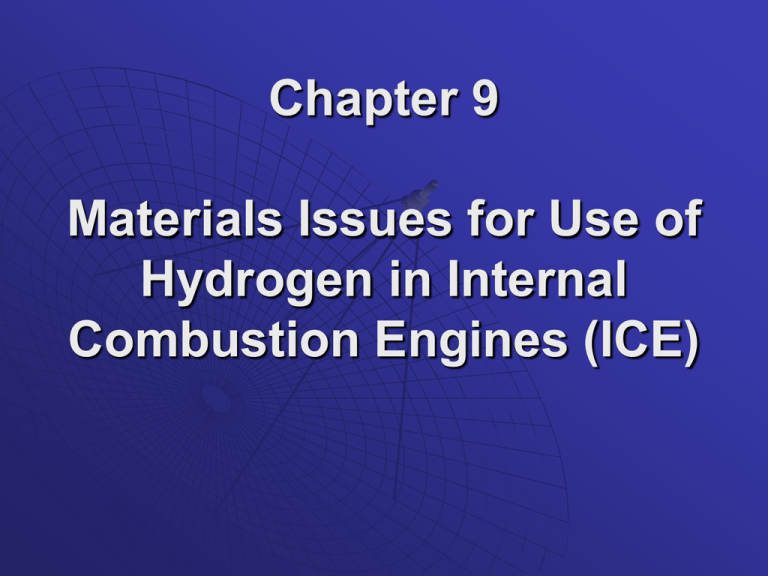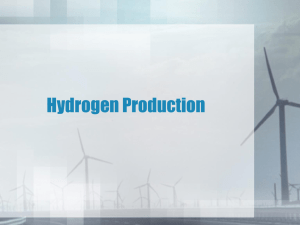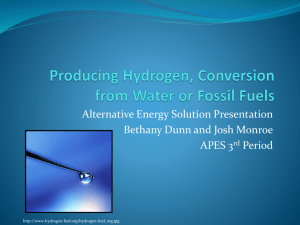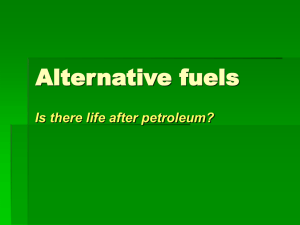Chapter 8 ICE
advertisement

Chapter 9 Materials Issues for Use of Hydrogen in Internal Combustion Engines (ICE) two-stroke engine in operation, with a tuned pipe exhaust Four-stroke cycle (or Otto cycle) 1. Intake 2. Compression 3. Power 4. Exhaust The Wankel cycle. The shaft turns three times for each rotation of the rotor around the lobe and once for each orbital revolution around the eccentric shaft. A hydrogen internal combustion engine vehicle (HICEV) is a type of hydrogen vehicle using an internal combustion engine. Hydrogen internal combustion engine vehicles are different from hydrogen fuel cell vehicles (which use hydrogen + oxygen rather than hydrogen + air); the hydrogen internal combustion engine is simply a modified version of the traditional gasoline-powered internal combustion engine. Filler neck for hydrogen of a BMW, Germany Tank for liquid hydrogen of Linde, Germany Introduction Internal combustion engines (ICEs) offer an efficient, clean, costeffective option for converting the chemical energy of hydrogen into mechanical energy. The basic of this technology exist today and could greatly accelerate the utilization of hydrogen for transportations. It is conceivable that ICE could be used in the long terms as well as a transition to fuel cells. However, little is known about the durability of an ICE burning hydrogen. The primary components that will be exposed to hydrogen and that could be affected by this exposure in an ICE are (1) fuel injectors, (2) valves and valve seats, (3) pistons, (4) rings, and (5) cylinder walls. A primary combustion product will be water vapor, and that could be an issue for aluminum pistons, but is not expected to be an issue for the exhaust system expect for corrosion. Fuel Injectors The combustion of hydrogen in an internal combustion engine is a technology to help expand the utilization of hydrogen fuel in the near term, before fuel cell technology is fully developed. In order to gain the highest efficiency, the use of direct injection will be needed. There are several elements to these injectors that could experience degradation in the presence of hydrogen: (1) injector body, (2) actuator, (3) epoxy used to encase the actuator, and (4) electrical contacts. Injector Body Injector bodies are made primarily form steels such as M2 (UNS T11302), H13 (T20813), and 4140 steel (UNS G41400). The alloy M2 is a high-carbon tool steel with a carbon concentration ranging between 0.8 and 1.05 %, while H13 is a tool steel with a carbon concentration of 0.3 to 0.45 % and 4140 steel is an alloy steel with a carbon concentration of 0.4 %. M2 is a highly alloyed tool steel with about 4 % Cr, 5 % Mo, 6 % W, and 2 % V. these elements are all carbide formers, so their combination with high carbon results in a significant volume fraction of carbides in the microstructure. These carbides provide wear resistance, which is needed for the pin and seat of the injector. H13 is a lower-alloy tool steel with approximately 1 % Si, 5 % Cr, 1 % Mo, and 1 % V. Alloy 4140 steel contains approximately 1 % Cr and 0.2 % Mo as the primary alloy additions. M2 has excellent retention to softening at temperature as high as 600 oC. This hardness retention results from the stable carbides. Composition and hardness are factors that directly affect the performance of these steels in hydrogen. Actuator Materials • Injectors may use electromagnetic or piezoelectric actuators to provide the active fuel control. • Some actuators for direct H injection utilize piezoelectric wafers made of lead zirconium titanate (PZT) embedded into an epoxy or other insulating material. • For direct injectors, the actuator is embedded in the hydrogen gas, which has the potential to affect performance by the following processes: 1) change the capacitance of the PZT 2) mechanical failure or cracking of the PZT 3) separation of the PZT wafers 4) debonding of electrical connections 5) degradation of the epoxy or polymer casing materials Hydrogen Effects on Internal Engine Components A number of internal components, such as valves, valve seats, cylinder walls, pistons, and rings, will be exposed to hydrogen and water vapor. The potential effects are of two primary types: (1) decarburization of steels and cast iron and (2) hydrogen embrittlement of aluminum pistons. Water vapor could cause excessive corrosion of exhaust systems, but this could be minimized by use of titanium. Decarburization Effects • Decarburization occurs in steels and cast irons in hydrogen gas by the reaction of H with C in the steel. • The decarburization rate is primary dependent on the diffusion rate C in the steel, but is also affected by the carbon content of the steel, alloying elements in the steel, such as chromium, impurities in the hydrogen, and of course time and temperature. • Carburization of steels, reverse of decarburization, is usually conducted at temperature of about 900 oC, but decarburization can occur at temperature as low as 800 oC. Exhaust valves have the highest operating temperature of components in an internal combustion engine, and they typically operate at maximum of 790 oC, while intake valves have a maximum operating temperature of 540 oC. Light-duty intake valves are typically made from SAE 1547, which is an iron-based alloy with 1.5 % Mn and 0.57 % C. For higher-temperature application, the ferritic stainless steel alloy 422 is used. This alloy has about 8.5 % Cr, 3.25 % Si and 0.22 % C. Because exhaust valves operate at higher temperatures, materials with a higher alloy content are used. A primary alloy for exhaust valves is 21-2N, which has 21 % Cr, 2 % N. Other alloys used for exhaust applications, depending on the desired operating temperatures, are 21-4N, 23-8N, Inconel 751, Pyromet 31, and nimonic 80A. Valves used for heavy-duty application have one of these alloys for the valves head with a hardenable martensitic stem. Hydrogen Embrittlement of Pistons • Aluminum pistons in an engine that burns H2 will be exposed to not only H2 but also H2O at temperatures of 80 to 120 oC. • Aluminum alloys can be totally immune to H2 embtittlement and H2-induced crack growth if the natural Al2O3 oxide is intact. • However, there are processes that can disrupt this film, and it is know that aluminum alloys will absorb H2 when exposed to H2O vapor at 70 oC. • There will also be periods when the engine is cool and condensed water will be present so that aqueous corrosion could occur, but this is not expected to be any different than with an engine with cast aluminum pistons that burns gasoline. • H is very insoluble in Al at 25 oC and 1 atm pressure, with values ranging from 10-17 to 10-11 atom fraction. • There are several studies that resulted in diffusion coefficient at 25 oC of about 10-17 cm2/sec for Al. References Materials for the Hydrogen Economy, Jones, R. H. and Thomas, G. J., ed., CRC Press, Boca Raton, 2008. http://en.wikipedia.org/wiki/Internal_combustion_engine http://en.wikipedia.org/wiki/Hydrogen_internal_combustion _engine_vehicle Hydrogen Use in Internal Combustion Engines, Hydrogen Fuel Cell Engines and Related Technologies, College of Desert, 2001.






